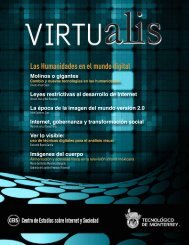P
terranova-network-culture
terranova-network-culture
- No tags were found...
You also want an ePaper? Increase the reach of your titles
YUMPU automatically turns print PDFs into web optimized ePapers that Google loves.
Three Propositions on Informational Cultures 31informational microstructure able to produce living organisms byinducing the chemical reactions leading to the conversion of energyinto differentiated types of cells.This notion that information was somehow related to anti-entropicor negentropic forces is at the basis of the informationalist perspectivethat identifies information with a kind of form determining thematerial unfolding of life. Echoes of informationalism are present inall statements that argue that informational genetic sequencesdetermine not only skin and hair colour, but even our very actionsand feelings. This interpretation of the relation between informationand entropy is not confirmed, however, by most of the current workin genetic or molecular biology, where the DNA macromolecule isunderstood as a simple inductor within the complex environmentof the cell. Rather than expressing a deterministic relation betweeninformational structures such as the DNA and a biophysicalphenomenon such as the organism, the informational trendemphasizes the nonlinear relationship between molecular or microlevels of organization and molar or macro layers. 35 Likethermodynamics and statistical mechanics, information theorysuggests that a macro-state or a molar formation (such as an averagetemperature; or an organism; or an ‘identity’) does not have a linearor deterministic relation to the multiplicity of the microscopic statesthat define it (the singular particles and their velocities; themicroscopic relations that make up an organism; the mutations andvariations that underlie all identities).In its technical and scientific sense, then, information impliesa ‘representation’ of a physical state, but there is no assumedresemblance between the representation and the state that it describes.Within the statistical model proposed by Quetelet’s social physics, forexample, the ‘average’ or ‘norm’ is the representation of a macrostateto which can correspond a variety of microstates. An average mightbe the same for a number of different possibilities (an average heightof 6 feet in a population of 100 people might be realized by manydifferent distributions of possible heights). As a macrostate, theaverage does not really exist, but it is a kind of social norm, a strangeattractor endowed with the function to regulate the social body andstabilize it. It is the centre of gravity to which ‘all the phenomena ofequilibrium and its movement refers’. 36 Like the mass society thatin those same years was increasingly preoccupying conservative andradical critics alike, thermodynamics and statistical mechanics toowere concerned with formations such as masses, quantities such








